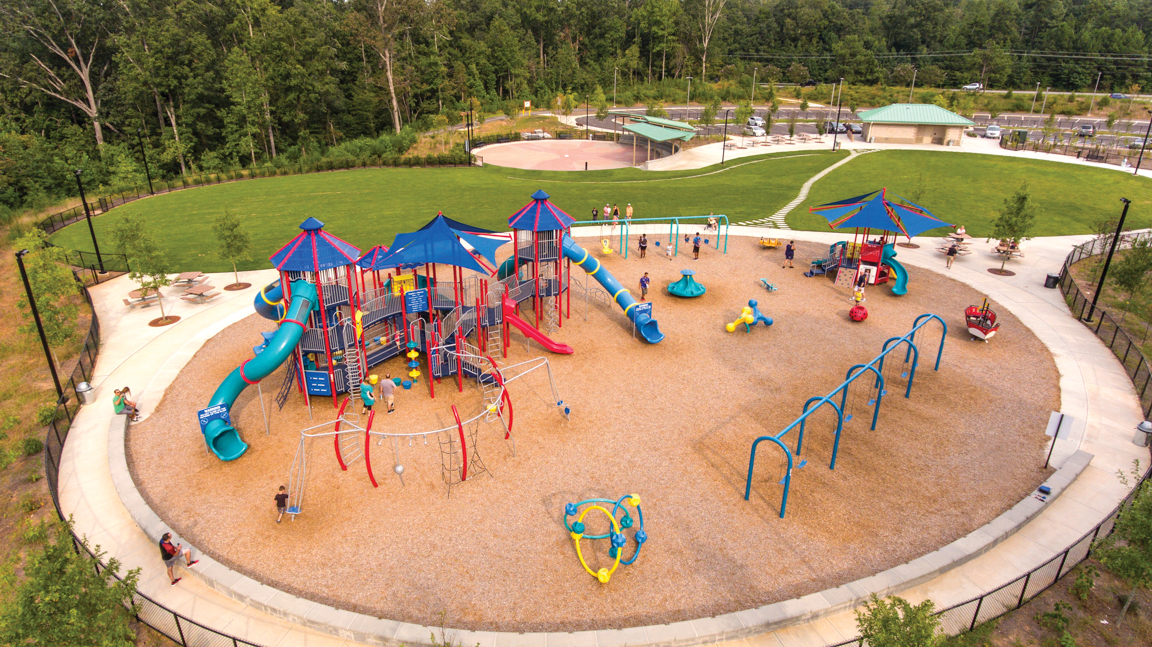Using Color to Enhance Playgrounds
Posted by May Recreation Content Team on

There’s nothing quite like the joy of watching a child’s face when they are introduced to their first big Crayola box full of vibrant and fascinating colors.
Vivid Tangerine! Mango Tango! Caribbean Green! Robin’s Egg Blue! Pink Flamingo! Timberwolf! So many colors to allow a child’s imagination to run wild.
The same concept applies to playgrounds where colors can enhance the experience.
“A brightly colored playground may catch a child’s attention and spark curiosity,” says Miracle Recreation. “Colors also help kids associate other aspects of their environment, such as temperature, danger, lighting, food, and nature. Colors may impact kids’ learning and behavior more than you might realize. This is why it’s so important to offer colorful, vivid spaces for them to discover.”
Benefit of Color in a Child’s Environment
How dull would it be if we only lived in a black-and-white world? Children, especially, need color in their environment as it can affect everything from energy levels to how they learn.
“We want to create spaces where children want to be. In the spaces we experience, few design elements are as high-impact and low-cost as color,” says architectural firm LS3P. “A well-chosen color scheme can improve safety, support mental focus, protect vision, elevate mood, assist with wayfinding, promote kindness, encourage active learning, reinforce branding, and create a welcoming learning environment for all.”
Here are some reasons that color matters in a child’s environment:
- Stimulation and Engagement: Bright colors can capture children's attention, stimulating their senses and encouraging exploration.
- Emotional Response: Colors evoke emotions, affecting mood and behavior. Vibrant hues can promote feelings of happiness and excitement, fostering a positive atmosphere.
- Safety Awareness: Using contrasting colors for equipment and surfaces can help children easily distinguish between different areas, promoting safety and reducing the risk of accidents.
- Learning and Creativity: Colorful environments can spark children's creativity and imagination, creating a conducive space for learning through play.
- Inclusivity and Accessibility: Colorful designs can make playgrounds more inclusive for children with visual impairments, as contrasting colors aid in navigation and participation.
- Affects Circadian Rhythm: Color may improve children’s sleep. Brightly colored classrooms and play spaces can help make children feel awake during the day while warm lighting and darker colors can entice children to feel sleepy at night. This keeps their circadian rhythm in tune.
Exploring How Different Colors Affect Children
Colors have the remarkable ability to evoke emotions, influence behavior, and stimulate cognitive processes, making them powerful tools for enhancing the playground environment.
Understanding how different colors impact children can inform intentional design choices, creating dynamic and engaging spaces that cater to their developmental needs and preferences.
Let's explore how a spectrum of colors can influence and enhance children's experiences in playground settings:
- Red: Energizing and stimulating, red can promote physical activity and excitement.
- Blue: Calming and serene, blue can encourage relaxation and peaceful play.
- Yellow: Cheerful and uplifting, yellow fosters happiness and optimism.
- Green: Refreshing and natural, green inspires exploration and connection with nature.
- Orange: Energetic and playful, orange encourages social interaction and creativity.
- Purple: Imaginative and mysterious, purple stimulates creativity and introspection.
- Pink: Gentle and nurturing, pink promotes empathy and emotional expression.
- Brown: Grounding and earthy, brown provides stability and a sense of security.
- White: Clean and minimalist, white creates a blank canvas for imaginative play and creativity.
- Black: Bold and dramatic, black adds contrast and depth, enhancing visual interest.
Of course, not all children react the same way to color, but playground designers can use the above color “cheat sheet” to help build their spaces.
Best Practices for Using Color in Playground Design
Creating a vibrant and welcoming playground involves more than just splashing colors across equipment and surfaces—it requires thoughtful consideration of design principles and user needs.
Implementing best practices ensures that color choices not only enhance the visual appeal of the playground but also contribute to safety, inclusivity, and user engagement.
By adhering to established guidelines and principles, designers can craft playgrounds that are not only aesthetically pleasing but also enriching environments for children to learn, play, and grow.
“When it comes to play, the use of color should be rooted in happiness, fun, and energy. For instance, a bright yellow slide can instantly draw a child’s attention when they go outside for recess. A light blue swing might be used to help kids feel a sense of peace as they whoosh through the air. Bright colors and fun patterns on a playground may even encourage kids to create their own make-believe stories and games,” says Miracle Recreation.
Here are some best practices to keep in mind when using color in playground design:
- Consider Cultural Preferences: Be mindful of cultural associations with colors to ensure inclusivity and sensitivity.
- Balance and Harmony: Use a balanced combination of colors to create a visually appealing and cohesive design.
- Safety First: Prioritize safety by choosing non-toxic, durable paints and materials that withstand outdoor conditions.
- Age Appropriateness: Tailor color choices to suit the age group of the intended users, considering both developmental needs and preferences.
- Environmental Integration: Incorporate colors that complement the surrounding environment, enhancing the playground's aesthetic appeal and harmony with nature.
- User Engagement: Involve children in the color selection process to promote a sense of ownership and connection to the playground.
- Accessibility: Ensure color choices accommodate children with visual impairments, using contrasting colors and tactile elements for inclusivity.
- Maintenance Considerations: Select colors that are easy to maintain and touch up over time, minimizing the need for frequent repainting.
- Thematic Elements: Integrate color schemes that align with specific themes or educational objectives to enhance storytelling and imaginative play.
- Continuous Evaluation: Regularly assess the impact of color on user experience and make adjustments as needed to optimize the playground's design and functionality.
Incorporating color into playground design is a dynamic and multifaceted process that requires careful attention to detail and user experience.
By embracing best practices and staying attuned to evolving trends and user needs, designers can continue to push the boundaries of playground design, creating spaces that inspire and delight generations of children to come.
Contact May Recreation today in the greater Houston area for a colorful recreational design concept for your playground.
